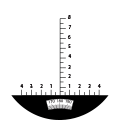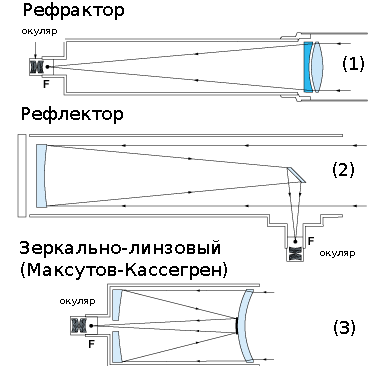
Telescopes
Telescopes. What telescope to buy?
Telescope - a tool for observing astronomical objects. C using the telescope to observe the planets, comets, the Moon, and other objects such as star clusters, galaxies, etc.
- Accessories to telescopes (23)
- Astronomical binoculars (20)
- Telescopes Sturman (17)
-

Adapter Kenko T-mount for Olympus and Panasonic designed for the connection of the elements of the system MILTOL (teleconverter, ocular head) and the lenses with thread T-mount for digital camera lens mount micro 4/3 (Panasonic and Olympus).
- Thread diameter — 42 mm, thread pitch is 0.75 mm;
- Operating part — of 38.67 mm;
- Product dimensions 54,4x6. 6 mm. -

Adapter Kenko T-mount for Pentax K mount for lenses with a threaded T-mount for digital camera with Pentax K mount and attach the elements of the system MILTOL (lens, teleconverter Kenko 2x, eyepiece attachment).
- Thread diameter — 42 mm, thread pitch is 0.75 mm;
- Working distance — 45.5 mm;
- Dimensions — 58х8,1 mm. -

Adapter Kenko T-mount for Sony E is designed for mounting lenses with threaded T-mount for digital camera mount Sony E and adding elements of the system MILTOL (lens, teleconverter Kenko 2x, eyepiece attachment).
- Thread diameter — 42 mm, thread pitch is 0.75 mm;
- Working distance: 18 mm;
- Dimensions — 58,2x9 mm. -

Camera telescope Sturman Solar system's CMOS (color) for studying, photo and video objects in the Solar system:
- A color sensor on the basis of CMOS of a matrix, sensitivity 1.0 v/Lux-sec;
- Video 640x480 (VGA);
- Bore diameter of 1.25” (31.75 mm) and inner threads for mounting additional accessories;
- USB 1.1 / 2.0 interface;
- Supported operating systems – Microsoft Windows XP, Vista, 7 (x32 and x64). -

Camera telescope Sturman 0.8 M for studying, photo and video shooting of objects of the sky:
- Sensor on the basis of CMOS of a matrix;
- Screen size 640x480 (VGA);
- Bore diameter of 1.25” (31.75 mm) and inner threads for mounting additional accessories;
Interface USB 2.0;
- Supported operating systems – Microsoft Windows 98 / 2000 / XP, Vista, 7 (x32 and x64). -

Binoculars 10x50 Sturman ATAKER for the initial terrestrial and astronomical observations
- Magnification 10x, diameter of lens - 50 mm
- Field of view is 6.5° (114 m/1000m), exit pupil diameter - 19 mm
- Porro prism glass BaK-4
Multi - layer coating of the lenses
The Central focus at a distance of 5 m
- Waterproof rubber housing-aluminum alloys, turn-and-slide eyecups
- Installation on a tripod using adapter (sold separately)
- Comes with PU leather case, covers lenses and eyepieces, a wide shoulder strap -

Binoculars Sturman ATAKER 8-20х50 for monitoring moving objects and the initial actionability
- Magnification 8-20x diameter of lens - 50 mm
- Field of view is 4.2 and 2.6° (73-45 m/1000m), exit pupil diameter - 16.5 mm
- Porro prism glass BaK-4
Multi - layer coating of the lenses
The Central focus at a distance of 5 m
- Waterproof rubber housing-aluminum alloy
- Installation on a tripod using adapter (sold separately)
- Comes with PU leather case, covers lenses and eyepieces, a wide shoulder strap -


All-weather binoculars Sturman 7x50 with built in compass for hunting Hiking and nature observation
- Increase 7x, diameter of lens - 50 mm
- Field of view is 7.6° (132 m/1000m), exit pupil diameter - 23 mm
- Porro Prism
- Aspherical lens with a multilayer anti-reflective coating
- Separate focus at distance of 4 m, the diopter adjustment (-5 to+8 diopters)
- Built in compass with illuminated dial and angular mesh
- Rubber coated waterproof body, rubber eyecups
- Nitrogen filling
- Tripod mounting via adapter (sold separately)
- Comes with protective caps, bag and strap in the color of the body of the binoculars -

Planetary binoculars 15x70 Sturman for astronomical and terrestrial observations
- Magnification 15x diameter of the lens - 70 mm
- Field of view - 4.4 degrees (77 m/1000m), exit pupil diameter - 18 mm
- Porro prism glass BaK4
Multi - layer coating of the lenses
The Central focus at a distance of 13 m
- Rubber-coated housing made of aluminum alloy
- Mounted on a tripod via adapter (optional)
- Comes with protective caps, strap & case -

Powerful field binoculars 20x50 Sturman camouflage for ground-based observations because of the highly remote objects
- Magnification 20x diameter of lens - 50 mm
- Field of view is 3.2° (56 m/1000m)
- Porro prism glass Bk-7
Multi - layer coating of the lenses
The Central focus at a distance of 10 m
- Rubber-coated housing made of aluminium alloy, color camouflage (khaki)
- Mounted on a tripod via adapter (optional)
- Comes with protective caps, shoulder strap and case -

Binoculars 12x50 Sturman for wildlife observation and much remote objects
- Magnification - 12x, diameter of lens - 50 mm
- The field of view of 5.6° (97 m/1000m), exit pupil diameter - 11 mm
- Porro prism glass Bk-7
Multi - layer coating of the lenses
The Central focus at a distance of 5 m
- Housing - the combination of impact-resistant plastic and aluminium alloy, rubber, color green
- Mounted on a tripod (1/4") using adapter (sold separately)
- Comes with protective caps, strap and case -

Field glasses Sturman 20x60 camouflage for terrestrial or astronomical observations because of the highly remote objects
- Magnification 20x, lens diameter 60 mm
- The field of view of 3.4° (59,6 m/1000m), exit pupil diameter - 9 mm
- Porro prism glass Bk-7
Multi - layer coating of the lenses
The Central focus at a distance of 5 m
- Rubber impact-resistant housing made of aluminum alloy, color camouflage (khaki)
- Mounted on a tripod via adapter (optional)
- Comes with protective caps, shoulder strap and case -

Binoculars 12x50 Sturman camouflage for wildlife observation and much remote objects
- Magnification - 12x, diameter of lens - 50 mm
- The field of view of 5.6° (97 m/1000m), exit pupil diameter - 11 mm
- Porro prism glass Bk-7
Multi - layer coating of the lenses
The Central focus at a distance of 5 m
- Housing - the combination of impact-resistant plastic and aluminium alloy, rubber, color "camouflage"
- Mounted on a tripod (1/4") using adapter (sold separately)
- Comes with protective caps, strap and case

















